Text: Elina Lewe
What is Extended Producer Responsibility (EPR) in the textile industry?
According to the OECD, EPR is a “market-based instrument used to promote total lifecycle environmental improvements of product systems by extending the responsibilities of the manufacturer of the product to various parts of the product’s lifecycle, and especially to take-back, recovery and final disposal of the product”.
“Producer” refers to an entity that professionally manufactures, sells, imports or releases textiles on a market. This can be for example, brands and retailers in the textile sector. Another important actor in the EPR process is the Producer Responsibility Organization (PRO). It organises the collection and the management of post-consumer products for several producers and it is usually a Non-Profit Organisation. The PROs charge their members, which are the producers, a minimum fee that allows them to organise the collection, sorting and treatment of the textile waste. The size of the fee is depending on the quantity of new products placed on the market. The pressure generated by the EPR should reward sustainable productions, by, for example, reducing these fees accordingly. This is called eco-modulation. The PROs will typically make contracts with existing collection and sorting organisations, like municipalities or charities, and new actors that will organise the collection activities. These contracted organisations are called operators. The relations between these actors is explained in figure 1.
PROs need to be committed to prioritise reuse before recycling and if not possible to prioritise recycling back into fibres for new textiles products before down-cycling, according to the waste hierarchy.
Figure 1: EPR system
The EPR concept for the textile sector is mentioned in the EU Strategy for sustainable and circular textiles. The European Commission sees the harmonisation of national EPR schemes as necessary and is working towards an agreement for a single eco-modulation concept. In order to make this possible, common definitions and set targets from EU level are needed.
A well working EPR system has many benefits. It provides the appropriate push and funding for systems to improve the management of textile waste, for example in developing and upscaling automated sorting and textile recycling technologies. It makes it legally mandatory to manage textile waste hierarchy and can act as an economic instrument to achieve better design to reduce the cost of end-of-life management. Moreover, it can influence the consumption reduction depending on the EPR fee that is set, since the costs covered by EPR can increase the upfront price paid by the consumer for textile products.
At the moment, different EU member states have started to set up their own EPR schemes. Since the European Commission has not formulated specific rules or guidelines for these schemes, there are differences in scope, definitions and objectives, and in general different national interpretations. This can lead to economic disruptions, and problems at collection and sorting stages, barriers to cross-border shipment within and outside of the EU. The plan of the European Commission is to have one general framework and not 27 different ones, to allow producers to consider the EPR schemes holistically and not nationally.
France is the only member state that already has an EPR system for textiles in place. EPR has been a legal requirement since 2007 for clothing, linen and footwear items. It requires producers to contribute to the collection, sorting and recovery costs of used textile items. Re-Fashion is a take-back scheme operator who is the acting PRO. With contributions paid by producers, they ensure the waste management and prevention costs. All producers concerned by the EPR must register with an administrative authority. This registration guarantees a membership to a take-back scheme operator, or the producer can instead implement an individual waste management system. The eco-fee modulation is the first driver for progress in order to promote high environmental value products. The fees for producers vary between 10 Cents and 4.50€ with an average of 0.5€ per item. Those who design or import goods in an ecological way will benefit from a bonus in regards to the financial contribution.
The Netherlands will start with their EPR scheme for textiles in the beginning of 2023. Sweden, Finland, Norway, Bulgaria, Greece and Spain also have specific plans in place for their own EPR schemes.
So what would the EPR for textiles mean for brands and businesses in the sector? If the brand is placing textiles on the EU market, it acts as a “producer”. This means, if the EPR for textiles becomes mandatory, they have to either set up their own take-back scheme or they need to pay a certain fee, based on the amount of textiles placed on the market, to an organisation that takes care of the textiles at the end-of-life. However, the first step of the implementation of EPR will be the registration of the producers to the managing entity, for example a specific ministry. In the Netherlands, for example, the producers need to report until 15.02.2023 what type of textile products they place on the market, how many pieces, the volume, weight and what measures are being taken for collecting the textiles at the end-of-life and how they will finance that.
The separate collection of textile waste in the EU will become mandatory in 2024, which is why a lot of member states are planning to start implementing their EPR scheme either then or in 2025.
Sources
COSH!. (n.d.). Status update of the Dutch EPR scheme going into 2023. https://cosh.eco/blog/upv-nederland-update-circulartextiledays-2022.
ECESP Circular Economy. (November 8, 2021). #EUCircularTalks: Exploring EPR for textiles – taking responsibility for Europe’s textile waste [Video]. https://www.youtube.com/watch?v=RE8pH_MceeQ&t=4977s.
EURATEX (October 21, 2020). Extended Producer Responsibility (EPR) in Textile products. EURATEX position paper. Brussels. https://euratex.eu/wp-content/uploads/EPR-position-paper-FIN.pdf.
Watson, D., Kiørboe, N., Palm, D., Tekie, H., Ekvall, T., Lindhqvist, T., … Gíslason, S. (2015). EPR-systems and new business models : Part II: Policy packages to increase reuse and recycling of textiles in the Nordic region. https://doi.org/10.6027/TN2015-514.

